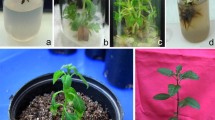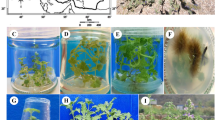Abstract
Turmeric (Curcuma longa L.), a high valued medicinal plant, was micropropagated through induction of multiple shoots using latent axillary buds of rhizome. Cytophotometric and random amplified polymorphic DNA (RAPD) as well as inter simple sequence repeats (ISSR) analysis were used to periodically monitor the genetic stability of micropropagated clones of Curcuma longa conserved in vitro up to 7 years at every 6 months interval. A total of eighteen RAPD and eight ISSR primers gave 45,537 distinct and reproducible bands, monomorphic across all 353 plants analyzed. Micropropagated turmeric after being conserved for 7 years in vitro was transplanted into soil in field. Drug yielding potential of tissue culture derived plants was evaluated in field through estimation of phytoconstituents like curcumin and essential oil contents. The result of 2 years of field trial showed that micropropagated turmeric retained stability in all the characteristics examined when compared with the field performance of conventionally propagated plants. Thus long term conservation of an elite genotype of turmeric with epigenetic and genetic stability is significant for stable supply of drug i.e., curcumin and essential oil to the market.

Similar content being viewed by others
References
Ashmore SE (1997) Status report on the development and application of in vitro techniques for the conservation and use of plant genetic resources. International Plant Genetic Resources Institute, Rome, Italy, p 67
Balachandran SM, Bhat SR, Chandel KPS (1990) In vitro clonal multiplication of turmeric (Curcuma longa) and ginger (Zingiber officinale Rosc.). Plant Cell Rep 3:521–524
Behura S, Srivastava VK (2004) Essential oils of leaves of curcuma species, J Essent Oil Res
Bhatia R, Singh KP, Jhang T, Sharma TR (2009) Assesment of genetic fidelity of micropropagated gerbera plants by ISSR markers. Sci Hort 11(2):208–211
Doyle JJ, Doyle JL (1990) A rapid DNA isolation procedure for small quantities of fresh leaf tissue. Phytochem Bull 19:11–15
Goto S, Thakur RC, Ishii K (1998) Determination of genetic stability in long term micropropagated shoots of Pinus thunbergii Parl. Using RAPD markers. Plant Cell Rep 18:193–197
Gould AR (1986) Factors controlling generation of variability in vitro. In: Vasil IK (ed) Cell culture and somatic cell genetics in plants 3, plant regeneration and genetic variability. Academic, Orlando, pp 549–567
Guenther E (1972) In: Robert E (ed) The essential oils, vol 1, Krieger Publication Co, Huntington, New York, pp 361–391
Hammerschlag FA, Bauchan GR, Scorza R (1987) Factors influencing in vitro multiplication and rooting of peach cultivars. Plant Cell Tissue Organ Cult 8:235–242
Hartmann C, Henry Y, De Buyser J, Aubry C, Rode A (1989) Identification of new mitochondrial genome organizations in wheat plants regenerated from somatic tissue cultures. Theor Appl Genet 77:169–175
Hatano K, Kamura K, Shoyama Y, Nishioka I (1988) Clonal propagation of Aconitum carmichaeli by tip tissue culture and alkaloid contents of clonally propagated plants. Planta Med 54:152–154
Hussey G (1986) Problems and prospects in the in vitro propagation of herbaceous plants. In: Withers LA, Aldeson PG (eds) Plant tissue culture and its agricultural application. Butterworths, London, pp 113–123
Joshi P, Dhawan V (2007) Assessment of genetic fidelity of micropropagated Swertia chirayita plantlets by ISSR marker assay. Biol Plant 51(1):22–26
Kuanar A, Mohanty S, Panda MK, Nayak S (2009) Essential oils from leaves of micropropagated turmeric. Curr Sci 96:1166–1167
LarKns P, Scowcroft WR (1981) Somaclonal variation, a novel source of variability from cell cultures for plant improvement. Theor Appl Genet 60:197–214
Leela NK, Tava A, Shafi PM, Chempakam B (2002) Chemical composition of essential oils of turmeric (Curcuma longa L.). Acta Pharml 52:137–141
Martins M, Sarmento D, Oliveira MM (2004) Genetic stability of micropropagated almond plantlets, as assessed by RAPD and ISSR markers. Plant Cell Rep 23:492–496
Mohanty S, Panda MK, Subudhi E, Acharya L, Nayak S (2008) Genetic stability of micropropagated ginger derived from axillary bud through cytophotometric and RAPD analysis. Z Naturforsch 63c:747–754
Mohanty S, Joshi RK, Subudhi E, Sahoo S, Nayak S (2010) Assessment of genetic stability of micropropagated Curcuma caesia through cytophotometric and molecular analysis. Cytologia 75(1):73–81
Morata-Renau B, Nebauer SG, Arrillaga I, Segura J (2005) Assesment of somaclonal variation in micropropagated shoots of Cedrus:consequences axillary bud breaKng. Tree Genet Gen 1:3–10
Murashige T, Skoog F (1962) A revised medium for rapid growth and bioassay with tobacco tissue cultures. Physiol Plant 15:473–497
Nadgauda RS, Mascarenhas AF, Hendre RR, Jagannathan V (1978) Rapid clonal multiplication of turmeric Curcuma longa L plants by tissue culture. Ind J Exp Biol 16:120–122
Nayak S, Naik PK (2006) Factors affecting in vitro micro rhizome formation and growth in Curcuma longa and improved field performance of micropropagated plants. Sci Asia 32:31–37
Nayak S, Sen S (1991) Cytological and cytophotometrical analysis of direct explants and callus derived plants of Ornthogallum thrysoids Jacq. Cytologia 56:297–302
Nayak S, Sen S (1995) Rapid and stable propagation of Ornithgalam umbellatum L. in long term culture. Plant Cell Rep 15:150–153
Nayak S, Sen S (1997) Cytological and cytophotometrical analysis of callus and regereated palants of Ornthogallum virens. Cytobios 91:135–142
Nayak S, Sen S (1998) Differential resistance of three species of Ornithogalum to polyploidization in vitro. Nucleus 41:48–52
Nayak S, Debta BK, Sahoo S (1996) Rapid propagation of lemongrass (Cymbopogon flexuosus (Nees) Wats) through somatic embryogenesis in vitro plants. Plant Cell Rep 15:367–370
Nayak S, Mohanty S, Subudhi E (2008) Differential synthesis of essential oil in callus derived microshoots of turmeric (Curcuma longa) in vitro, in International conference of Association of plant tissue culture. 12–17th oct 2008, Dalian, China
Official Analytical Methods of the American Spice Trade Association (1997) Method No. 1.06. 4th edn. ASHA Press
Official Analytical Methods of the American Spice Trade Association (1997b) Method No. 1.09. 4th edn. ASHA Press
Orton TJ (1985) Genetic instability during embryogenic cloning of celery. Plant Cell Tissue Organ Cult 4:159–169
Panda MK, Mohanty S, Subudhi E, Acharya L, Nayak S (2007) Assessment of genetic stability of micropropagated plants of Curcuma longa L. by cytophotometry and RAPD analysis. Inter J Int Biol 1(3):189–195
Peredo EL, Arroyo-Garcia R, Revilla MA (2009) Epigenetic changes detected in micropropagated hop plants. J Plant Physiol 166(10):1101–1111
Potter R, Jones MGK (1991) An assessment of genetic stability of potato in vitro by molecular and phenotypic analysis. Plant Sci 76:239–248
Roses IA (1999) Medicinal plants of the world: chemical constituents, traditional and modern medicinal uses. Humana Press, New Jersey, pp 139–153
Rout GR, Das G (2002) An assessment of genetic integrity of micropropagated plants of Plumbago zeylanica by RAPD markers. Biol Plantarum 45(1):27–32
Salvi ND, George L, Eapen S (2001) Plant regeneration from leaf base callus of turmeric and random amplification polymorhic DNA analysis of regenerated plants. Plant Cell Tiss Org Cult 66:113–119
Salvi ND, George L, Eapen S (2002) Micropropagation and field evaluation of micropropagated plants of turmeric. Plant Cell Tiss Org Cult 68:143–151
Sharma AK, Sharma A (1980) Chromosome techniques: theory & practice. 3rd edn. Butterworths, London
Shenoy VB, Vasil IK (1992) Biochemical and molecular analysis of plants derived from embryogenic tissue cultures of napiergrass (Penisetum purpureum K. Schum.). Theor Appl Genet 83:947–955
Smykal P, Valledor L, Rodriguez R, Griga M (2007) Assesment of genetic and epigenetic stability in long term in vitro shoot culture of pea (Pisum sativum L.). Plant Cell Rep 26:1985–1998
Tyagi RK, Yusuf A, Dua P, Agrawal A (2004) In vitro plant regeneration and genotype conservation of eight wild species of Curcuma. Biol Plant 48:129–132
Tyagi RK, Agrawal A, Yusuf A (2006) Conservation of Zingiber germplasm through in vitro rhizome formation. Scientia Hortic 108:210–219
Van’t Hof J (1965) Relationships between mitotic cycle duration, S period duration and the average rate of DNA synthesis in the root meristem cells of several plants. Exp Cell Res 39:48–58
Williams JGK, Kubelik AR, Liva KJ, Rafalski JA, Tingey SV (1990) DNA polymorphisms amplified by arbitrary primers are useful as genetic markers. Nucl Acid Res 18:6531–6535
Xiaoqiang MA, Gang DR (2006) Metabolic profiling of in vitro micropropagated and conventionally greenhouse grown ginger (Zingiber officinale). Phytochemistry 67(20):2239–2255
Zeitkiewicz E, Rafalski A, Labuda D (1994) Genome finger printing by simple sequence repeat (SSR)-anchored PCR amplification. Genomics 20:176–183
Zucchi MI, Arizono H, Morais VI, Fungaro MHP, Vieira MLC (2002) Genetic instability of sugarcane plants derived from meristem cultures. Genet and Mol Biol 25(1):91–96
Acknowledgments
The authors are grateful to Prof. Dr. Sudam Chandra Si, Dean and Prof. Dr. Manoj Ranjan Nayak, President, Center of Biotechnology, Siksha O Anusandhan University, for providing all facilities.
Author information
Authors and Affiliations
Corresponding author
Rights and permissions
About this article
Cite this article
Nayak, S., Kaur, T., Mohanty, S. et al. In vitro and ex vitro evaluation of long-term micropropagated turmeric as analyzed through cytophotometry, phytoconstituents, biochemical and molecular markers. Plant Growth Regul 64, 91–98 (2011). https://doi.org/10.1007/s10725-010-9541-2
Received:
Accepted:
Published:
Issue Date:
DOI: https://doi.org/10.1007/s10725-010-9541-2




